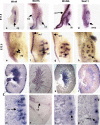Molecular regulation of kidney development: is the answer blowing in the Wnt?
- PMID: 17554566
- PMCID: PMC6949197
- DOI: 10.1007/s00467-007-0504-4
Molecular regulation of kidney development: is the answer blowing in the Wnt?
Abstract
Development of the metanephric kidney is a complicated process regulated by reciprocal signals from the ureteric bud and the metanephric mesenchyme that regulate tubule formation and epithelial branching morphogenesis. Over the past several years, several studies have suggested that Wnt signaling is involved in multiple aspects of normal kidney development as well as injury response and cancer progression. We will review these data here.
Figures





References
-
- Vize PD, Woolf AS, Bard JBL, editors. The kidney: from normal development to congenital disease. Boston: Academic Press; 2003.
-
- Duenhoelter JH, Pritchard JA. Fetal respiration. A review. Am J Obstet Gynecol. 1977;129:326–338. - PubMed
-
- Kobayashi A, Kwan KM, Carroll TJ, McMahon AP, Mendelsohn CL, Behringer RR. Distinct and sequential tissue-specific activities of the LIM-class homeobox gene Lim1 for tubular morphogenesis during kidney development. Development. 2005;132:2809–2823. - PubMed
-
- Grobstein C. Some transmission characteristics of the tubule-inducing influence on mouse metanephrogenic mesenchyme. Exp Cell Res. 1957;13:575–587. - PubMed
-
- Grobstein C. Inductive epithlio-mesenchymal interaction in cultured organ rudiments of the mouse metanephros. Science. 1953;118:52–55. - PubMed
Publication types
MeSH terms
Substances
LinkOut - more resources
Full Text Sources
Other Literature Sources
Miscellaneous

